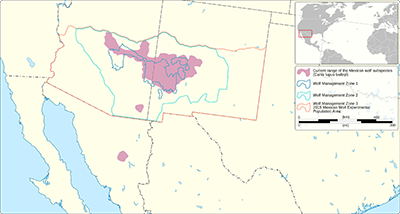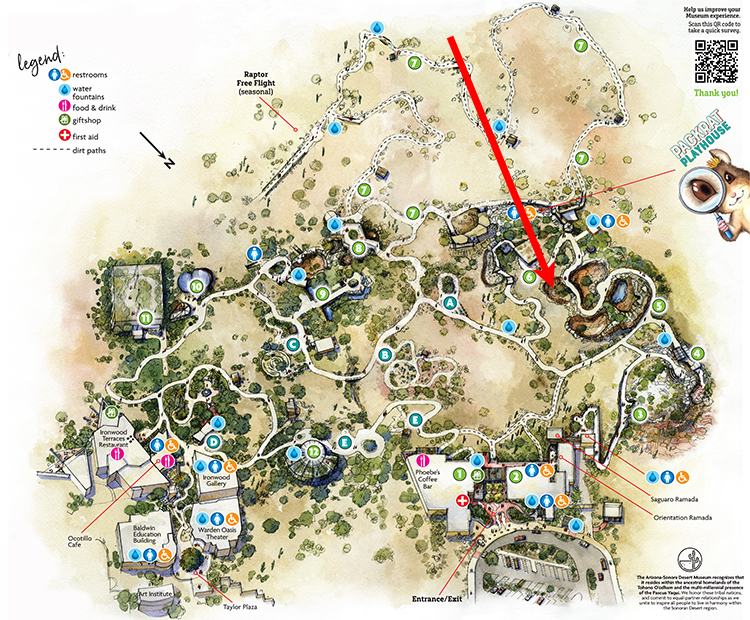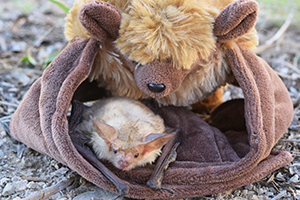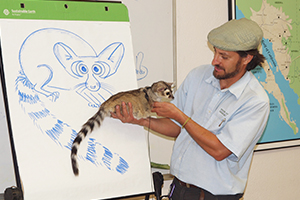Mexican Gray Wolf

Photo by Jay Pierstorff.
About
In fairy tales and folklore, storytellers and writers have depicted wolves as dangerous and cunning. However, in the real world, wolves pose little risk to people, generally staying within their packs, avoiding humans and their dwellings, and venturing near ranches or farms only when prey is scarce, and hunger draws them to the cattle, sheep, or chickens.
So, throughout history, wolves have posed little threat to humans. Over the last two centuries however, humans have further encroached upon wolf habitat in the Southwest United States and northern Mexico, creating conditions for greater conflict between our species. Wolves would enter these now human-dominated areas seeking prey in the form of livestock; ranchers and farmers in turn sought to minimize livestock loss by overhunting wolves.
This had devastating consequences for wolf populations. In the U.S., Mexican gray wolves used to number in the thousands, but by the 1930s they were close to extinct due to hunting, poaching, and poison, making them the most endangered gray wolf subspecies in the world and one of the most endangered mammals in the U.S. Fortunately, population recovery efforts have been underway since the 1970s and are encouraging — there are over 300 wolves in the care of zoos and other breeding facilities, and 286 in the wild (as of January 2025).
Adaptations
Like all wolves, Mexican grays travel in packs, allowing them to hunt large prey to feed their entire group. Their perked ears and acute sense of smell pick up even far-off sounds and scents, and their long legs allow them to run at speeds of 35-40 mph over short distances, around the average speed of a racehorse. For comparison, Arctic wolves are faster when hunting (46 mph) and red wolves slightly slower (30-35 mph). When simply roaming around their territory, Mexican grays trot along at 5 mph, about the speed of a power-walking human.
Food Web
Wolves are keystone species; these are species that are at the center of a particular ecosystem, maintaining its overall health and regulating its predator/prey populations and resources. They are also considered apex predators, at the top of the food chain in the wild. Typical prey includes large hooved animals (called ungulates), such as elk, deer, caribou, and pronghorn sheep as well as smaller animals, such as javelina and rabbits or even squirrels and chipmunks.
Hunting mostly at night, Mexican gray wolves rely on their superior senses of smell and hearing to track down prey and on their powerful jaws to incapacitate and kill their quarry quickly.

Habitat and Range
Due to plentiful cover, water, and prey, mountain woodlands are a preferred natural habitat for Mexican gray wolves though they also range across grasslands, scrublands, and the Sonoran and Chihuahuan deserts. Since reintroduction, the wolves have established home ranges of 50-400 square miles. In the wild, they live 6-8 years; in captivity, their lifespan is up to 15 years.
Right: Mexican gray wolf (Canis lupus baileyi) distribution in 2023. Boundaries indicate Wolf Management Zones designated by the US Fish and Wildlife Service.
By Goran_tek-en, CC BY-SA 4.0, https://commons.wikimedia.org/w/index.php?curid=142417099

Video and image content are copyrighted by the Wolf Conservation Center (www.nywolf.org).
Family Life
Mexican gray wolves are highly social animals, living in packs of 4-9 animals, comprised of one breeding pair (the alpha male and female, usually mates for life) and their offspring. They mate in February and March, with litters of 4-7 pups born about two months later. Young wolves stay with their pack of origin for at least two years before going off to join or establish another pack. Larger and heavier than the females, males are 28-32 in. tall at the shoulder and 5-5.5 ft. long from nose to tail tip, weighing 60-80 lbs.
Glossary
- Encroached
- to move into or take over an area
- Endangered
- a species (plant or animal) that is at risk of going extinct
- Erratic
- unpredictable and irregular changes in the size of a population
- Genetic Diversity
- range of different traits within a species
Fun Facts
- Wolves don’t howl at the moon, though the moon may be overhead; they howl to communicate with other members of the pack and to claim territory.
- Wolves communicate through scent, sound, and body language. Their sense of smell is 100 times stronger than that of humans; sounds include barks, snarls, yelps, whimpers, whines, and, of course, howls, which can be heard up to 10 miles away; and their body gestures—from bared teeth to tucked tail—are similar to a dog’s.
- Each pack has its own unique, identifying howl, allowing others in the pack to recognize it immediately.
- Every dog breed — from poodles to Great Danes—has descended from wolves.
Conservation
The U.S. Fish and Wildlife Service began reintroducing Mexican gray wolves into eastern Arizona in 1998. The initial population was 7 wolves (5 wild and 2 captive-bred). Growth has been erratic as the population takes hold, and inbreeding (which diminishes the genetic diversity necessary for stable population) is a concern, but there have been 8 consecutive years of population growth.
Today, the wild population comprises at least 286 wolves in Arizona and New Mexico (11% more than the previous year), 26 breeding pairs among them. In addition, 24 captive-bred pups were placed in dens in the last year or so, helping to boost genetic diversity. Organizations, such as Defenders of Wildlife, work with ranching communities and Indigenous nations to implement strategies for keeping both wolves and livestock safe, such as locating livestock away from wolf dens and using special fencing.
In May 2019, a pup (aptly nicknamed “Hope” for the hope she brings to Mexican wolf recovery) was flown to Arizona and successfully placed in the den of the wild Saffel pack through a “cross-foster.” Cross-fostering is a coordinated effort between the Mexican gray wolf Interagency Field Team (IFT) and the Mexican Wolf Species Survival Plan (MWSSP) and is a technique employed to enhance the genetic health of the wild gene pool of Mexican wolves. Captive-born pups are introduced into a similar-aged wild litter so the pups can grow up as wild wolves and aid in the recovery of their endangered species.
- Museum project links:
- Background on the Museums role in Mexican Gray Wolf Recovery: Desert Diaries
- Mexican Gray Wolves - Arizona-Sonora Desert Museum
- Saving Animals From Extinction (SAFE) species through AZA: SAFE Species
- IUCN Conservation Status
- Mexican Grey Wolves are listed as endangered under the Endangered Species Act and are included in the gray wolf entry on the IUCN Red List.
At The Museum
View on Map

Schedule (open year-round)
Accessibility (rough terrain & wheelchair accessible)










